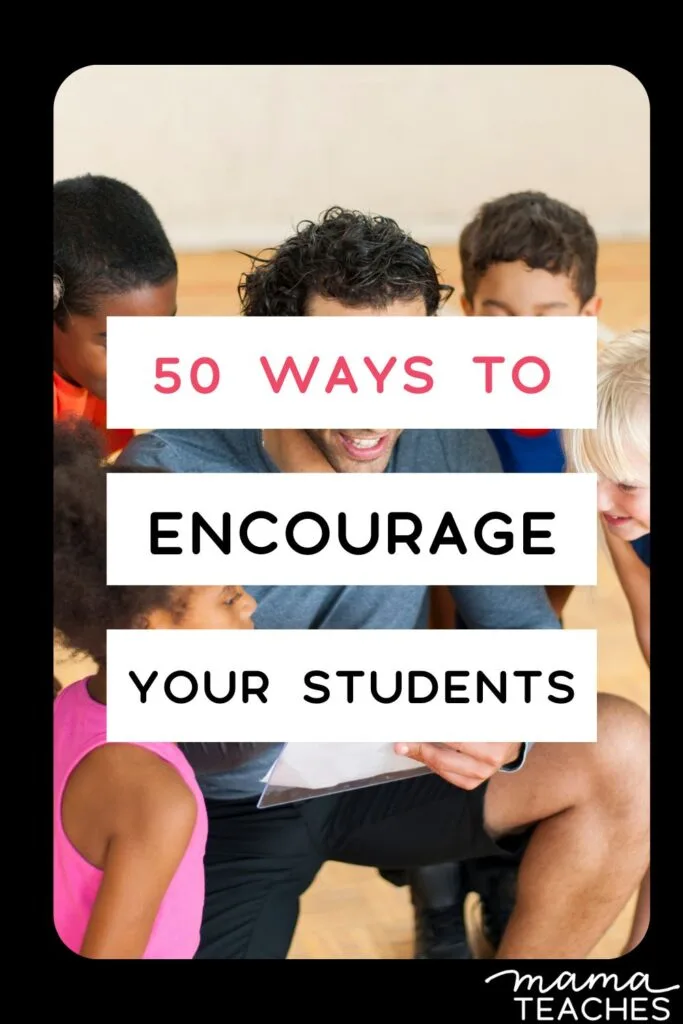It’s essential that kids feel valued and loved. So try out some unique ways to encourage students in your classroom today.

Student Encouragement
Students who feel valued and appreciated are more likely to push themselves to learn from the teachers they like. Every child deserves to feel loved and important.
Try some of these ways to encourage students to build positive relationships and keep the school year interesting.
These student encouragement strategies may be just what your behavior management plan needs at this point in the year.

50 Ways to Encourage Students
1. Create a positive and inclusive classroom
2. Show interest in students’ lives outside of school
3. Make learning fun and engaging
Not everything has to be a game, but surprising students by turning a worksheet into a game is sure to boost engagement and is a great way to encourage students to work hard.
4. Own your mistakes
Showing students that making mistakes is alright shows them that you aren’t perfect.
Student encouragement can be as easy as laughing at your mistake and admitting you are wrong.
In addition, it may inspire your students to take risks because mistakes are embraced in your classroom.
5. Offer praise for reasonable effort and work
Everyone loves to hear they did a good job.
If you see a student working hard on a task, especially if they usually don’t try challenging tasks, capitalize on that opportunity to encourage your students.

6. Use a variety of teaching strategies to meet different learning needs
It encourages students when they are taught in a way that meets their needs.
Knowing your students and their needs will help you determine what teaching strategies work best with your learners.
7. Encourage students to set their own goals
Students are told all day what to do and how to achieve it. Let them take ownership of some of their own goals.
8. Celebrate milestones and progress
When students reach milestones, celebrate them! This goes hand and hand with having students set their own goals.
9. Encourage creativity and innovation
10. Celebrate and respect cultural diversity

11. Provide opportunities for students to lead and take initiative
12. Recognize and value each student’s uniqueness and strengths
13. Give students the opportunities to showcase their talents and skills
14. Offer choices for how to complete tasks
When possible, give multiple ways for students to show what they know.
Not every student wants to write an essay, nor does every student want to make a slideshow.
Develop a rubric and let your students decide how they want to show you what they know.
15. Model positive behaviors and attitudes

16. Foster a growth mindset
17. Encourage students to take responsibility for their learning
This is a skill that will create lifelong learners. When you encourage students to become responsible for their learning, you teach them a valuable skill.
18. Use real-life scenarios to make learning more relevant
19. Utilize storytelling and narratives
20. Create a sense of excitement and anticipation around learning

21. Use humor and creativity in classroom management
If you can get kids to laugh, you have them in your hand.
Laughter is a great way to create a bond with your students to help with your classroom management.
Once you bond with your students, you can encourage them to do many things.
22. Provide opportunities for students to share their opinions and ideas
23. Emphasize hard work and effort
24. Incorporate physical activity into your lessons
25. Use music and art in lessons

26. Provide opportunities for students to connect with experts in a field
Students will work hard to come up with questions or to present their ideas because they worry about how they will appear to the expert.
27. Encourage students to use their imaginations
28. Allow peer feedback
29. Facilitate debate and discussions
Learning how to debate and discuss topics respectfully is an important life skill.
Some students may need more encouragement than others to debate and discuss.
Build various roles so that not every student has to address the class if they don’t want to.
30. Use role play and simulations
Helping students to see how situations play out will help encourage students who find themselves in similar situations.
This is especially important in character education-type classes.

31. Rely on positive reinforcement to motivate students
32. Teach relaxation and calming techniques
33. Help students build self-confidence and self-esteem
34. Use technology to enhance learning
When students know that learning won’t only consist of reading a textbook, students are encouraged to participate and pay attention in class.
35. Encourage reading for pleasure
Allow your students to pick books that interest them. If the book is too hard, they will quickly figure that out.
Trust and encourage students to read for fun and to ditch books that aren’t a good fit for them.

36. Use project-based learning
37. Utilize positive affirmations
38. Foster a love for learning and curiosity
Having a question board is one of the easiest ways to encourage students to be curious.
No question is too silly, and the questions can be anonymous, too (even though we all know you can tell who wrote it based on the handwriting).
39. Create a sense of ownership and pride for the classroom
Assigning classroom jobs could be one way to help students feel ownership and pride for their classroom.
Another way is to ask them what they would change.
Students come up with great ideas and have unique perspectives in the classroom.
What better way to encourage students than to bring their idea to life?
40. Provide opportunities for students to connect with the bigger community
Find ways to connect the learning in your classroom to the community at large.
Is there a problem in your community? Ask your students what they notice about their community and what they would change.
Allow them to write to government officials and propose ways to help their community.

41. Incorporate student interests into learning
Create word problems about topics of interest, allow students to show what they know however they like, or make a class about a particular interest (like Lego, animals, etc.).
Student engagement is sure to be high on that day.
42. Allow students to collaborate
43. Offer help for those who need (or want) it
44. Provide challenging but achievable tasks
Students may not know what they can do until you pose them with complex tasks.
45. Create a safe space for students to share their thoughts and ideas

46. Make time to check individually with students
Some students are too shy to ask for help. Carve out time to meet 1:1 with students and give them encouragement and praise while giving them feedback.
47. Help students develop good study habits and organizational skills
When students are taught how to stay organized and create good study habits, you show them that you care about them.
This will lead to student encouragement and for them to do well in school (and life).
48. Provide opportunities for self-expression
49. Help students build positive relationships with their peers
50. Be empathetic

Encourage Students
Students are still growing and learning. When you encourage students, you show them they are worthy and vital.
Every person needs to feel loved and encouraged to make positive changes in this world.
